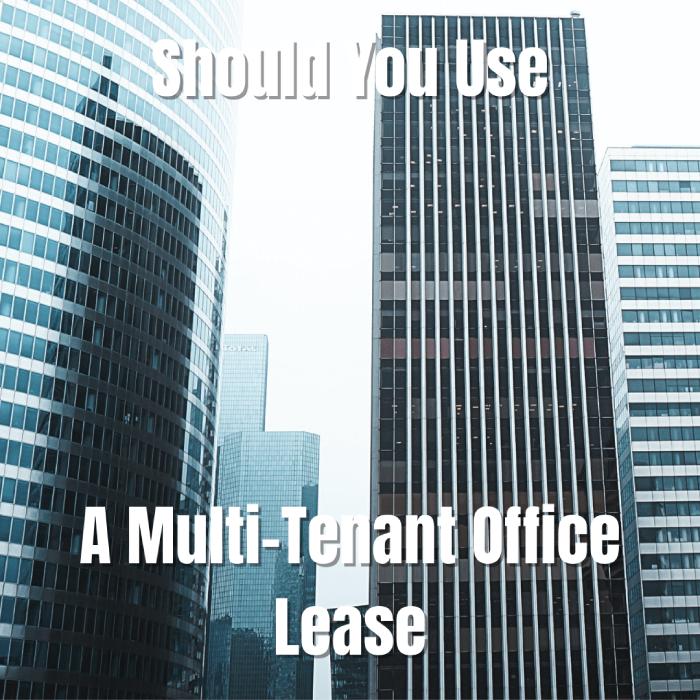To determine the best lease option for your business, you need to evaluate your investment needs.
Some crucial questions to ask yourself before start investing in commercial properties include:
- What is my investment goal?
- How involved do I want to be with the properties I own?
- How high or low is my risk tolerance?
- What are my wealth objectives?
After you have the answers to these questions sorted out, you need to understand the differences between a single-tenant and a multi-tenant lease and the pros and cons of each.
A single-tenant commercial lease entails investing in a property that you’ll rent to one tenant, while in a multi-tenant commercial lease, you’ll rent to several tenants. The main differences between the two kinds of leases include:
- Single-tenant properties only have one tenant to manage, while multi-property owners must manage multiple tenants.
- Single-tenant properties tend to have longer lease terms. A lease of 10-20 years is not uncommon. Multi-tenant properties have shorter lease terms, such as 3-7 years.
- Single-tenant properties require minimal capital input, where multi-tenant properties need regular capital input.
- Single-tenant properties tend to retain their value better where frequent tenant turnover in a multi-tenant property can lead to value loss.
Now that you understand the critical differences between the two let’s look at the pros and cons of multi-tenant leases to determine if investing in a multi-tenant property is the right decision for your investment goals.
Multi-Tenant Lease Pros
Multi-tenant leases have the appealing promise of regular income irrespective of the tenant turnover rate. The landlord can enjoy better returns with less involvement if they agree with the tenants to care for their utility, taxes, and personal maintenance needs. Here are the advantages you’ll enjoy with a multi-tenant lease:
Receive Rent from Multiple Tenants
Multi-tenant properties give you the benefits of several tenants paying rent. The multiple sources of income reduce the risk of losing vast amounts of income if one tenant vacates the property.
A multi-tenant lease lets you have different tenants with diverse lease types and durations, which buffer shifting economic times. The best property to utilize a multi-tenant lease is one that has:
- High consumer traffic
- Minimal vacancies history
- Excellent market trajectories
Maximizes Resources
A multi-tenant architecture layout promotes sharing and utilization of resources, enabling you to spread out maintenance costs.
A single-tenant lease requires the landlord to build a new working system or redo the property to suit the new tenant’s needs. On the other hand, a multi-tenant commercial lease promotes resource sharing, and minimal remodeling is required when a new tenant comes on board.
Enjoy More Benefits from Property Management Software
Property management software enables a landlord or property owner with multiple units to efficiently manage his property and tenants. The platform can handle tens of tenants, and you can automate activities such as:
- Rent collection
- Track rent escalations and long term leases
- Bill common area charges
- Bill scheduled charges
- Maintain chart of accounts
- Run reports
- Track expenses
Multi-Tenant Lease Cons
Despite the advantages of a multi-tenant commercial lease, they tend to be riskier and need active management with regular capital input for improvements and maintenance. Consider the following disadvantages before settling on a multi-tenant lease.
Irregular and Uncertain Income
Compared to single-tenant properties, multi-tenant properties have shorter leases which increase the likelihood of high tenant turnover. This uncertainty makes it difficult for you to project long-term income.
Lenders usually ask for higher interest rates which would lower your overall return on investment. Examples of multi-tenant properties with a likelihood of regular vacancies include:
- Shopping malls
- Retail strip centers
- Industrial warehouses
- Apartment complexes
- Office centers
High Maintenance Cost
Maintenance cost is the most significant drawback with multi-tenant leases. The landlord is solely in charge of maintenance and repairs of the hallways, sidewalks, parking lot, seating areas, and lobbies. The tasks involved in keeping your property in good condition include:
- Plumbing
- Painting
- Security system fixes
- Lawn care
- Pest control
- Snow removal and salting
- Fixing roof, HVAC, heating system, windows, and decks
These responsibilities can be time-consuming, expensive, and inconvenient.
Attend to Multiple Lease Agreement Terms
Meeting with prospective tenants to discuss lease terms is time-consuming. Each tenant comes with different requirements, even if you have standard clauses for everyone. You can employ a tenant management team to take some of the work off of your shoulders, but this means more expenses that you have to cover. You’ll need to weigh your options and choose one that’ll work for you.
Ensuring every tenant adheres to their lease terms and updating the terms can also be time-consuming, and the likelihood of missing some updates is possible. UnitConnect saw this need and built a property management software that provides updates and enables seamless follow-up.
Manage your Multi-Tenant Units with Property Management Software
A multi-tenant commercial lease is an excellent investment with great returns if you’re willing to carry out the extra work of management and maintenance. UnitConnect’s property management software takes care of most managerial tasks and helps you follow up with the maintenance needs.
Get in touch with our team and schedule a demo.






